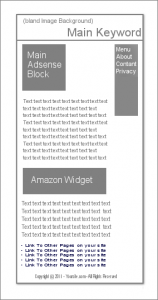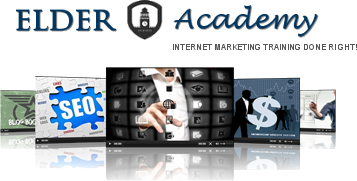Getting Started With Adsense
By: John Elder posted in Adsense
Hey everyone,
I thought I’d write a quick post about some of the more boring mechanical things regarding Adsense. Things like what my sites look like, how they’re composed, what kind of web hosting I use, etc etc. Basically, how to get started with Adsense.
SITE LAYOUT
Before you make any money in adsense, you have to build a website. And to do that you need to know what kind of site to build, and how it should look (and where to put your adsense ads).
There’s a ton of expensive Adsense courses out there that you can buy and there’s also a lot of expensive site templates you can buy (for wordpress, xsitepro, etc). I’ve tried a lot of them…and some of them work pretty good.
But eventually I stumbled on (through extensive trial and error) a site design that works best. I call it “any freakin desing you want”.
Yep.
It really doesn’t matter what your site looks like as long as you follow a few basic guidelines that I’ll explain.
1. The site should be simple. Don’t use flashy graphics. You want the ADSENSE AD to be the thing that stands out the most. Why? Because the whole point is to get people to click on that ad. Anything that takes away from that focus is bad. Minimalist site design is the rule to follow.
2. It doesn’t really matter what KIND of site you use, ie wordpress, xsitepro, or standard html…they all work the same. Personally I don’t use a CMS (content management system) like wordpress because they are resource hogs and I tend to build hundreds, even thousands of web sites at a time. Just the guts of wordpress alone for 1,000 websites on single server can bog you down, whereas a simple html file uses hardly any resources at all. This means I spend far less money on webhosting and bandwidth (But I’ll talk about that in detail in a later article).
3. Use TEXT adsense ads, not graphics. I’ve tested both and text ads pull better for me.
4. The site should almost be UGLY. You don’t want a good looking or useful website. I built an espresso machine website with custom graphics, and hundreds of articles of useful, well written, pertinent articles. What happened? People spent HOURS browsing the site, reading the articles, and learning all about espresso machines. Sounds good, but what I really wanted was for them to click an AD and leave the site!! The site was really popular, but made peanuts in income. Ugly is better!
5. You want to do some onpage SEO to responsibly link the pages of your site together so that the search engines can find all the pages of your site. I’ll discuss that in detail in a later post.
6. You’ll need 400-500 words of unique content for each page. I’ll get into that in detail later…
So what am I talking about design-wise? Here’s a simple pic I whipped up to show the basic layout of my sites.
This is just a basic example to show you the layout. My sites aren’t quite THAT simple…and I use a little color (not all gray like I’ve shown here), but hopefully you get the idea. Any variation of this basic layout should work for you. It doesn’t have to be any more difficult than that.
Basically you want a simple header graphic at the top (or no header graphic at all!) and a text H1 tag with your main keyword. Directly under that you want your text Adsense ad block.
On the right hand side of the screen you have a simple site menu that lists your “about me”, “contact me”, and “privacy policy” pages (privacy policy pages are important because Adsense requires that you have them in their terms of service). Under your main Adsense block put your written content, followed by your amazon widget, followed by your links to other pages on your site.
That’s basically it!
If you know how to use wordpress and are comfortable using it, then use wordpress. Same for xsitepro or joomla or any other CMS. I’ve used wordpress and I’ve used standard HTML hand-coding and I never see any difference in conversion levels or basic income between them. Go with what works for you.
The most important thing that I want to stress is that it doesn’t matter how your site is layed out. People obsess over this sort of thing and after several months fidgeting with it, end up giving up. Just crank something out…it doesn’t have to look good at all.
The important thing is to get on with it! Start cranking out websites and watch the Adsense income roll in. Later, once you get more experience, you can fidget with your sites and try to increase the conversion rates by adding different graphics, changing colors, using different layouts etc. But in the mean time…just start building based on the simple layout I’ve shown you here.
You’ll be surprised how easy it is to make money with ugly web sites!
Next you need to get those sites up on the Internet. Soon I’ll write an article all about webhosting…stay tuned.
Keep on building!
-John
The Marketing Fool!

















Marco
07. Dec, 2011
Hello Marketing Fool,
Do you put your adsense ads once you complete the website building or do you wait for the site gets some traffic?
The Marketing Fool
07. Dec, 2011
Hello Marco!
I place Adsense ads on the site immediately. I don’t ever wait for the site to get traffic. You’re just throwing away traffic otherwise. Some people feel that it’s harder to get a website indexed at Google initially if you have Adsense ads on there, but I’ve never found that to be true.
Marco
07. Dec, 2011
Hello again,
Thank you very much for your fast reply! I was worried about to place adsense ads to a new born site. I feel ok now.
The Marketing Fool
07. Dec, 2011
Happy to help!
Julius
31. Dec, 2011
Great site with valuable info you have here. From experience how many pages of content do you have for one site. Is it one page content per site? And how do you get the contents you use for your homepage before you spin it.
The Marketing Fool
09. Jan, 2012
Hi Julius,
I wrote one page of content with spin text and use that same one article on virtually every page of every web site. I wrote it myself and programmed all my sites to spin it automatically. As to how many pages I have for each site, that’s tricky. I create the sites to autogenerate infinite pages, each with different titles and focused on different keywords that get autogenerated into the text of that same one spun article…Google usually indexes between 10,000 to half a million of them for each site. I’ve discussed this process vaguely in some posts here at the site but plan on explaining it in greater detail soon.